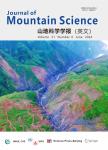Characteristics and dynamics of the Ganqiuchi rock avalanche triggered by a paleo-earthquake in the Northern Qinling Mountains
Ganqiuchi 岩石雪崩的特征和动力学在北 Qinling 山由 paleo 地震被触发作者机构:School of Geology Engineering and GeomaticsChang'an UniversityXi'an 710054China The Geopark of Shaanxi Cuihua MountainXi'an 710054China
出 版 物:《Journal of Mountain Science》 (山地科学学报(英文))
年 卷 期:2020年第17卷第5期
页 面:1143-1160页
核心收录:
学科分类:081803[工学-地质工程] 08[工学] 0818[工学-地质资源与地质工程]
基 金:financially supported by the National Natural Science Foundation of China(grant numbers 4167020392) the State Key Laboratory Foundation of Geohazard Prevention and Geoenvironment Protection(SKLGP2018K015) the Geological Investigation Project fromChina Geological Survey(DD20160336)
主 题:Ganqiuchi rock avalanche Deposit block size distribution Fragmentation Discrete element method Rock avalanche dynamics
摘 要:Analyzing large prehistoric rock avalanches provides significant data for evaluating the disaster posed by these relatively infrequent but destructive geological events. This paper attempts to study the characteristics and dynamics of the Ganqiuchi granitic rock avalanche, in the middle of the northern margin of Qinling Mountains, 30 km to the south of Xi’an, Shaanxi Province, China. In plane view, this rock avalanche is characterized by source area, accumulation area and dammed lake area. Based on previous studies, historical records and regional geological data, the major trigger of the Ganqiuchi rock avalanche is considered to be a strong paleo-earthquake with tremendous energy. The in situ deposit block size distributions of the intact rock mass and the debris deposits are presented and analyzed by using a simple model for estimating the number of fragmentation cycles that the blocks underwent. The results show that the primary controlling factor of the fragmentation process is the pre-existing fractures, and there is a relationship between the potential energy and the fragmentation energy: the latter is approximately 20% of the former. Based on the dynamic discrete element technique, the study proposes a four-stage model for the dynamic course of the Ganqiuchi rock avalanche:(1) failing;(2) highspeed sliding;(3) collision with obstacles;(4) decelerated sliding, which has implication for hazard assessment of the potential rock avalanches in China and other countries with similar geological setting.



